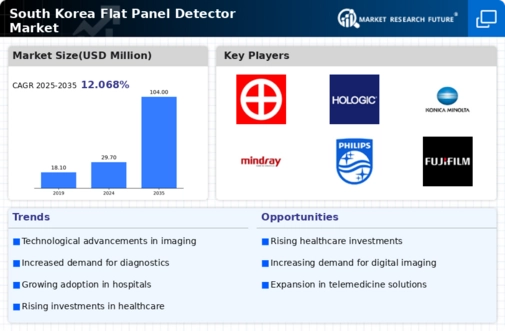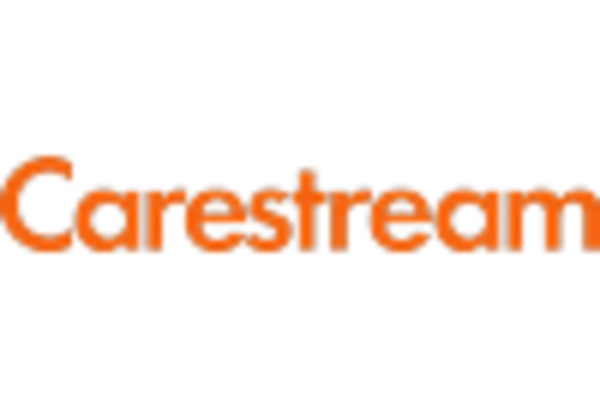Surge in Diagnostic Imaging
The flat panel-detector market is witnessing a surge in demand driven by the increasing prevalence of chronic diseases in South Korea. With conditions such as cardiovascular diseases and cancer on the rise, there is a heightened need for effective diagnostic imaging solutions. The market for diagnostic imaging is expected to grow at a CAGR of around 8% through 2025, reflecting the urgent need for advanced imaging technologies. Flat panel detectors, known for their superior image quality and reduced radiation exposure, are becoming essential tools in hospitals and diagnostic centers. This growing emphasis on accurate diagnostics is likely to propel the flat panel-detector market forward, as healthcare providers seek to enhance their diagnostic capabilities.
Rising Healthcare Investments
The flat panel-detector market in South Korea is experiencing a notable boost due to increasing investments in healthcare infrastructure. The government has been allocating substantial budgets to enhance medical facilities, which includes the procurement of advanced imaging technologies. In 2025, healthcare spending is projected to reach approximately $200 billion, with a significant portion directed towards diagnostic imaging equipment. This trend indicates a growing recognition of the importance of early diagnosis and treatment, thereby driving demand for flat panel detectors. Furthermore, as hospitals and clinics upgrade their imaging systems, the flat panel-detector market is likely to benefit from this influx of capital, leading to enhanced product offerings and improved patient outcomes.
Growing Focus on Patient Safety
In South Korea, there is a growing emphasis on patient safety and radiation protection, which is influencing the flat panel-detector market. As awareness of the risks associated with radiation exposure increases, healthcare facilities are prioritizing the use of imaging technologies that minimize these risks. Flat panel detectors are recognized for their ability to deliver high-quality images with lower radiation doses compared to traditional systems. This focus on patient safety is likely to drive healthcare providers to invest in flat panel detectors, thereby expanding the market. Additionally, regulatory bodies are increasingly advocating for the adoption of safer imaging technologies, further supporting the growth of the flat panel-detector market.
Expansion of Telemedicine Services
The expansion of telemedicine services in South Korea is emerging as a significant driver for the flat panel-detector market. As healthcare providers increasingly adopt telehealth solutions, the demand for high-quality imaging that can be transmitted remotely is on the rise. Flat panel detectors, with their ability to produce high-resolution images quickly, are well-suited for this purpose. The telemedicine market in South Korea is projected to grow at a CAGR of 15% through 2025, indicating a robust demand for remote diagnostic capabilities. This trend suggests that the flat panel-detector market will likely benefit from the integration of imaging technologies into telehealth platforms, enhancing access to quality healthcare services across the nation.
Technological Integration in Imaging Systems
The integration of advanced technologies into imaging systems is a key driver for the flat panel-detector market. Innovations such as artificial intelligence (AI) and machine learning are being increasingly incorporated into imaging modalities, enhancing the efficiency and accuracy of diagnoses. In South Korea, the adoption of AI in radiology is projected to grow significantly, with an estimated market value of $1 billion by 2026. This technological evolution not only improves the functionality of flat panel detectors but also increases their appeal to healthcare providers. As hospitals seek to adopt cutting-edge technologies, the flat panel-detector market is likely to see a corresponding rise in demand, as these detectors are integral to modern imaging solutions.

















Leave a Comment